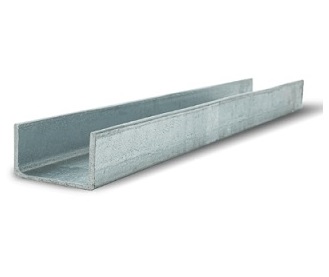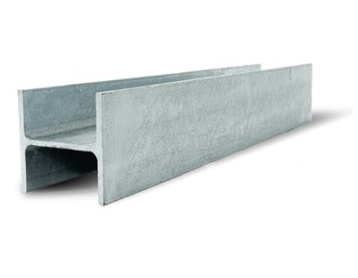H-beams and I-beams are beams that are used in steel construction, due to their strength and durability. Whether it’d be homes, bridges, or skyscrapers, beams are a crucial part of their support structure. Each of these beam types has its own distinct qualities and uses.
Due to their similarities, many inexperienced individuals mistake the two beams for each other. They look similar as they’re shaped almost identically, but there are several key differences that you should be aware of.
What are Steel Beams Used For?
We’ve already mentioned steel beams are almost everywhere in residential and industrial facilities, but let’s examine what a beam does. A steel beam’s job is to support heavy loads, increasing the strength and stability of your main structure. They’re also designed to resist shear force so it doesn’t buckle or tear apart – an excellent property to have if you’re located in areas prone to seismic activity.
READ: How to Build a Sleeper Retaining Wall with Steel Posts in 8 Steps
Beams are used as structural elements to support buildings, acting as either a primary or secondary support i.e a support frame or the load-bearing column to withstand load from another element of the structure.
Beams are determined by their shapes i.e H or I, size, material and how they’re connected to your building’s structure. While the beams discussed in this article are made from steel, other materials such as timber, or concrete can also be used.
Not sure if you should use Timber or Concrete for your retaining walls? Check out this guide.
How to Tell Which is a H-beam and I-beam

H-beams and I-beams’ primary difference lies in their cross-sections. While both have a horizontal and vertical element to their structure, H-beams have longer flanges and a thicker centre web than I-beams. The web, which is the vertical element, is responsible for resisting shear forces while the top and bottom flanges resist bending.
Like the names suggest, a H-beam’s structure resembles the letter H, and I-beams are shaped like the letter I. The I-beam has flanges that curve inwards to create its unique shape, whereas the H-beam’s flanges do not.
The Primary Differences Between a H-beams and I-beams
How They’re Made
These steel beams require precise manufacturing processes that include either milling or rolling. Due to its tapered flanges, I-beams are typically less straightforward to make than H-beams.
H-Beams, meanwhile, are made of rolled steel, and require metal to be welded together. The flanges are welded to the web to create its H shape.
Beam Thickness
I-beam webs are thinner than H-beam webs, which means they can’t hold as much weight but are typically lighter. This makes I-beams suitable for smaller projects like residential buildings, whereas H-beams are ideal for larger and taller structures like bridges.
H-beam flanges are also wider, longer and heavier than I-beams.
How High Can Concrete Sleepers Retaining Wall Go? Check out this article!
Beam Cross-sections
The cross-section of a H-beam has greater strength per unit area than the I-beam. This makes the H-beam an overall stronger beam with a decent strength-to-weight ratio. As H-beams have large surface areas, they’re great for carrying heavy loads.
I-beams, on the other hand, have cross-sections that are higher than the width of its flanges. This makes the steel beams ideal against local buckling, where individual parts and plate elements of the beam are put under extreme pressure.
Beam Inertia
The moment of inertia is greater for H-beams, making them more resistant against bending than I-beams.
Beam Height and Weight

I-beams are lighter and thinner than H-beams, and only span between 33 to 100 feet due to their complex shape. H-beams can span to 300 feet, making them the obvious choice for very tall structures. However, due to the I-beams being relatively lightweight, they are more suited for shorter spans and projects that require less weight bearing.
Beam Resistance Against Loads
Both beams have enough strength to withstand direct and tensile loads. However, H-beams are better at withstanding twisting loads as their cross-sections are larger and broader. As such, torsional deformation is less likely to occur when using H-beams.
Beam Practical Uses in Structures
I-beams are better as support frames and columns, typically used for elevators, trailers, houses and structural steel buildings. H-beams, meanwhile, withstand compression and tension and are used to support vertical loads like girders, and cables.
Beam Cost
When both beams can provide the same structural support, an H-beam is generally cheaper than an I-beam. This is due to the manufacturing process, as H-beams are cheaper and easier to make.
Which Beam is Better?

H-beams may appear like the obvious choice – they’re cheaper, have a greater capacity to withstand loads and are more resistant to bending. However, I-beams are lighter, easier to work with and have high tensile strength. This makes them ideal to handle direct pressure, and are used for steel framed buildings.
As H-beams have a thicker cross-section and a greater strength to unit area than I-beams, they are more suited to twisting loads and shear force. I-beams, on the other hand, are lighter, and have high tensile strength, ideal for withstanding direct loads.
Depending on your unique project and what you need your steel beams to do, either beam type can be the right choice. It’s essential to weigh up all of your options before making a decision.
If aside from steel beams and concrete sleepers in Melbourne, you need retaining wall installers, be sure to check out our installation services here at Retaining Wall Supplies. Our services are also available in Brisbane, Gold Coast, and Sunshine Coast.
Looking for more DIY retaining wall tips? Here’s a guide on How to Weld a Colorbond Fence on Top of a Concrete Sleeper Retaining Wall and How Much Does A Concrete Sleeper Retaining Wall Cost?


